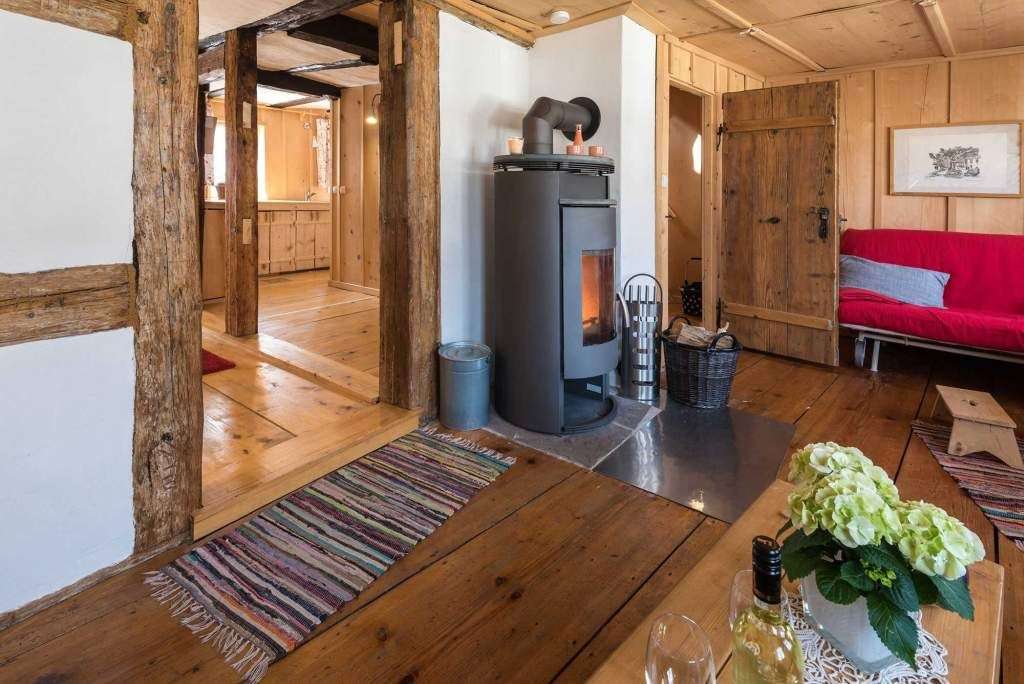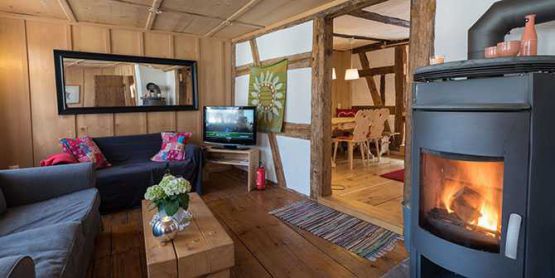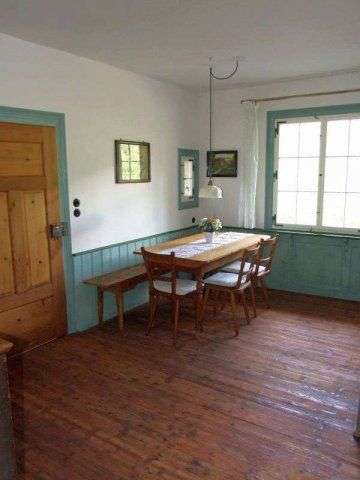
This was stated in the news bulletin for the city of Alpirsbach No. 23 on June 8, 2012. After intensive work, Mr. Hartmut Knortz transformed a very old, almost dilapidated building into a gem. We would like to thank him and his wife Nora for their commitment.
How old is this building? We don't know exactly, but we can provide some information that goes back over a quarter of a millennium. In 1805 it is described as follows:
An extension to building No. 135 (= Gerbergasse 20), in which an apartment is upstairs and a red tanner's workshop downstairs, between the street on one side and Andreas Köbelen Garden on the other, meets Hß at the front. Jerg Faßnacht's residence and at the back of Andreas Köbelen's and Ludwig Weitbrechten's residence. This was previously a Metzig, which Sigmund Leibiger owned, but was later converted into a saddlery workshop by Christoph Leibiger.
In 1784, Gabriel Köbele modified this building, added a new addition to the house, set up a parlor and chamber upstairs and a red tanner's workshop downstairs, using wood from the monastery forests. Wood report 1784 fol. 42 b.

There is a wonderful holiday home in the historic tanner's house that will take you back to times gone by. But it also offers modern comfort. Among other things, with a sauna and a small, beautiful garden. Within walking distance and yet quiet in the old town directly on the Kinzig.

Owner Andreas Köbele, previously Gabriel Köbele.
The building owner, like almost all citizens of Alpirsbach, Rötenbach and Reutin, was entitled to purchase timber worth two-thirds of the current price. Incidentally, the monastery office's wooden reports have been preserved in the Stuttgart Main State Archives and are a treasure trove for domestic and family researchers.
A small insert as a tip If you love historic holiday homes, then take a look at the Rottweil holiday apartment in the historic Vogtshof and the Hofgut Bärenschlössle mansion - the Freudenstadt holiday home .

In the lintel of the house entrance, in addition to the tanner's guild symbol and the year 1783, you can read the letters G and K, which stand for Gabriel Köbele. The difference between the written tradition and the house inscription can be explained by the fact that the renovation of the building lasted from 1783 to 1784.
The personal information corresponds to the entries in the Alpirsbach church records, which senior teacher Georg Albrecht (1881-1964) evaluated in an exemplary manner.
Let's start with the butcher Sigmund Leibiger (born 1713). In 1746 he married Maria Margareta, a daughter of the tailor's guild master Johann Friedrich Wörner. Ten children were born to their marriage, of which the sons Georg Jakob lived in Frankfurt and Gottlieb Heinrich settled in Brabant.
The Leibiger had been there since the beginning of the 18th century. The burgeoning Wittich and Reinerzau mining for silver and cobalt from the “depleted” mines in Saxony (Erzgebirge) and Thuringia (Harz) were attracted and found appropriate use as proven experts. The best-known example is the Leibiger.
Sigmund's father was Konrad Leibiger (1695-1744), a senior at the “Güte Gottes” in Wittichen, his mother was a daughter of the carpenter Friedrich Maser. “He was only 21 years old when he married, born in Neuenstadt, now Neustädtel, near Schneeberg, where his father, Alexander Leibiger, was a naturalized citizen, later in Eckershausen, Principality of Eisenach. Neustädtel and Schneeberg are small towns that grew out of mining and have now grown together. The main mines there supplied cobalt and silver, as did Alpirsbach, Reinerzau and Wittichen. They are very close to Aue, the now famous or infamous mine for uranium ore.” (Georg Albrecht). Most of Konrad's twelve children died young; only Sigmund and Karl Friedrich (as bakers) were able to start families.
Christoph Friedrich Leibiger (1749-1794), Sigmund's eldest son, had become a saddler and set up a saddlery workshop in keeping with his profession. There must have been enough buyers for his products, as there were still enough horses and cows in Alpirsbach and its (monastery) offices at that time.
He had six children with his wife Elisabeth Barbara, a daughter of the goalkeeper Johann Christoph Schneider. The office of monastery goalkeeper has been around since the second half of the 16th century. testified. In 1619 “Torhans” Hans Schwenk, who worked in the monastery office for over 40 years, died. Its functions other than opening and closing the two gates (upper between Oberamtei and Schalander, lower at the former hospital) are not known. He was a son of the monastery cooper Johann Friedrich Schneider (1722-1765).
His father Johann Schneider (1684-1771) had already been a monastery cooper. As a reminder: the wine must obtained in Breisgau was made in Alpirsbach. What remained in addition to the salary wine for officials and pastors was sold.
The Köbele / Köbelin family has been attested in Alpirsbach since 1701. At that time, the red tanner Gabriel Köbele (1666-1735) married the baker's daughter Sabina Barbara Hetzel, who died in the same year at the age of 22.
The second marriage to Jakobina Mick, who was probably born in Nordweil / Breisgau, produced, among other things, the son Matthias Köbele, who, as a red tanner, was also a climber at the Eberhard and Unverhofft Glück mines and most recently acted as an official messenger. Born in 1707, in 1735 he married Sophia Elisabeth, a daughter of the Fürstenberg mountain master Daniel Zobel from Wittichen.
A brother of Matthias K. was Georg Jakob Köbele (1717-1777), also a red tanner and court relative (= local councilor). In his marriage to the stocking weaver's daughter Agnes Margareta Stortz (1721-1789), his son Gabriel Köbele was born in 1758, who died unmarried in 1784 and was no longer able to enjoy the renovation. His brother Andreas then took over the property (see below).
The neighbors of the two Köbeles were Hannß Jerg Faßnacht, Andreas Köbele and Ludwig Weitbrecht. Johann Georg Faßnacht (1749-1789) was a white tanner. His father came from Reutlingen. He himself had twelve children with the Alpirsbach blacksmith's daughter Christina Maria Adrion (1753-1818), most of whom found their income outside, such as the sons Johann Christian and Gottlieb in Switzerland.

Get inspiration for your family vacation with children on our website. Find out about our holiday apartments and holiday homes for your holidays with children. When you register for the newsletter, you will receive our 30-page e-book with our personal insider tips for your family leisure time by email.
By submitting this form, you agree that we will send you advertising and information material about our services by email. You can object to the use of your email address free of charge at any time using the unsubscribe link contained in our emails or by sending a message to info@schwarzwald-ferienhaus.net. Further information can be found in our privacy policy .
Andreas Köbele (1762-1819) was married twice, first to Anna Maria Trautwein (1765-1805), and after her death to CordulaWössner, a daughter of the farmer Matthäus Wössner from Dieboldsberg. Anna Maria came from a widespread Schiltach family. Her father Johann Georg Trautwein was an iron factor and red tanner.
Johann Ludwig Weitbrecht (1740-1806), a son of the customs clerk Johann Jakob Weitbrecht (1704-1778), was a tailor and had married the daughter Johanna Christina of the tailor's guild master Hans Friedrich Wörner, who died in 1819 at the age of 81. She was a sister of Sigmund Leibiger's wife (see above).
Now we can look forward to the “Open Monument Day” on September 9th, when the couple Hartmut and Nora Knortz will open the tanner’s house to all interested parties.
Sources:
Description of the buildings and farms that are entitled to use the fair timber, 1805 (Alpirsbach City Archives)
Georg Albrecht: Alpirsbacher Families I-IV undated (archive of the Protestant parish in Alpirsbach).
The text was published here with the kind permission of Karl-Martin Hummel.
The former guard post WP 61 on the Black Forest Railway was lovingly and carefully renovated to enable its users to take a special journey through time. Holidays in a monument is the name of the concept, which is based on the original condition of a monument and thus provides unique living experiences.
The house is in a secluded location directly on the railway line above 78098 Triberg-Gremmelsbach.
More information: www.ferien-im-baudenkmal.de



Heiko Roth
Schillerstraße 62
72275 Alpirsbach
Telephone: +49 7444 4130
Email: anfrage@schwarzwald-ferienhaus.net
